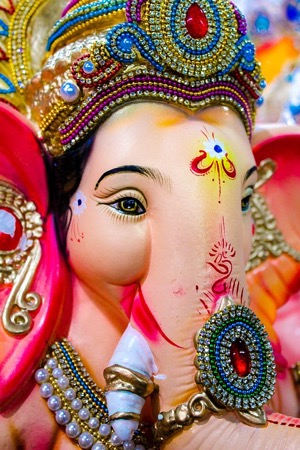SATURDAY, AUGUST 22: The sight of thousands of colorful, detailed elephant-type figures and the scent of sweet modak treats signal that Ganesha Chaturthi has arrived in India!
That is—in most years! During the COVID-19 pandemic, there will be fewer processions and smaller crowds. And, there may be colorful treats in store for people who are interested in Indian culture around the world. News reports say many communities that usually produce elaborate in-person Ganesh programs are, instead, focusing on producing virtual celebrations. Here’s a tip: Starting around August 21, Google “Ganesh Chaturthi” in YouTube and in Google News and you are likely to find links to cultural festivals you can stream wherever you are isolated these days.
After all, Ganesh Chaturthi is one of the grandest, most beloved and longest festivals in many regions of India, and the Hindu god Ganesha is honored during this time, known also as Vinayaka Chaturthi. For 10 days—until Anant Chaturdashi—many Jain, Christian and Muslim families across India join Hindus in celebrating the event. Images of Ganesha are temporarily installed in public pandals (shrines) and in homes, until they are taken to a local body of water and immersed.
Did you know? Lord Ganesha is believed to be the giver of fortune and one who can remove all obstacles to success.
Months before Ganesh Chaturthi, artists mold models of the elephant-god. Figures may range in size from less than one inch to almost 100 feet, most of them made of clay, Plaster-of-Paris, papier-mache or organic materials. In many areas of India, artists and industries earn a considerable portion of their yearly income preparing for Ganesh Chaturthi. Some regions host fairs, concerts, skits and dancing during the festival. Where an image of Ganesh is installed, the surrounding area is decorated with floral garlands, lights and more. Priests chant mantras to invoke Ganesha’s presence into the statues.
From a Hindu scholar: A few years ago, the Hindu writer and activist Padma Kuppa wrote a guest column in FeedTheSpirit, sharing her perspective on the holiday. And, Padma includes a delicious, traditional recipe as well. She included in this column additional links to learn more about the holiday and its beloved foods.
GANESH: CLAY & PLASTER, FROM INDIA TO THE UK—AND BEYOND
Though clay models used to be the primary material of Ganesh figures, demand and price led to the use of Plaster-of-Paris, which is not biodegradable. When Plaster-of-Paris Ganesh statues were immersed into water—also covered in chemical paints that contain heavy metals—water pollution began threatening the environment and statues began washing up on sandy beaches. In response, green initiatives have been launched across India. In Goa, the sale of Ganesh figures made of PoP was banned and a return to traditional clay or reusable figures is growing in popularity. In some areas, pools are set up for the safe immersion of statues.
Tens of thousands of Hindus in the UK publicly observe Ganesh Chaturthi, from Paris to London and beyond. In the U.S., temples and associations mark the festival, and the Philadelphia Ganesh Festival (PGF) is the largest Hindu festival in North America. Ganesha is also celebrated across Canada, in Malaysia and Singapore and in Indian populations around the world.


Tell Us What You Think